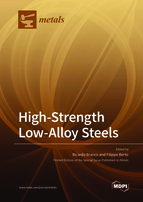High-Strength Low-Alloy Steels
A special issue of Metals (ISSN 2075-4701).
Deadline for manuscript submissions: closed (31 December 2019) | Viewed by 93051
Special Issue Editors
Interests: fatigue of advanced and traditional materials; fracture mechanics; solid mechanics; structural integrity; additive materials
Special Issues, Collections and Topics in MDPI journals
Interests: fatigue and fracture behavior of materials; mechanical characterization; structural integrity of conventional and innovative materials
Special Issues, Collections and Topics in MDPI journals
Special Issue Information
Dear Colleagues,
High-strength low-alloy steels are designed to provide specific desirable combinations of properties, such as strength, toughness, formability, weldability, and corrosion resistance. These features make them ideal for critical applications that operate under severe service conditions and in aggressive environments, namely automotive and aeronautical components, offshore and bridge structures, construction machinery and pipelines, to mention just a few. Despite the huge progress achieved over time on the behaviour of high-strength low-alloy steels, the development of more sophisticated products, combined with new manufacturing methodologies and new processing techniques, require additional research to address the new unsolved questions and to strengthen the existing knowledge in the field.
The goal of this Special Issue is to foster the dissemination of the latest research devoted to high-strength low-alloy steels from different perspectives, more specifically: the assessment of structural integrity, experimental analysis and numerical modelling of mechanical behaviour, damage and failure under static and dynamic loading, alloy design and microstructural evaluation, the influence of environmental mediums, and advanced applications. Both experimental and numerical approaches are encouraged. Literature review articles are also welcome.
Prof. Ricardo Branco
Prof. Filippo Berto
Guest Editors
Manuscript Submission Information
Manuscripts should be submitted online at www.mdpi.com by registering and logging in to this website. Once you are registered, click here to go to the submission form. Manuscripts can be submitted until the deadline. All submissions that pass pre-check are peer-reviewed. Accepted papers will be published continuously in the journal (as soon as accepted) and will be listed together on the special issue website. Research articles, review articles as well as short communications are invited. For planned papers, a title and short abstract (about 100 words) can be sent to the Editorial Office for announcement on this website.
Submitted manuscripts should not have been published previously, nor be under consideration for publication elsewhere (except conference proceedings papers). All manuscripts are thoroughly refereed through a single-blind peer-review process. A guide for authors and other relevant information for submission of manuscripts is available on the Instructions for Authors page. Metals is an international peer-reviewed open access monthly journal published by MDPI.
Please visit the Instructions for Authors page before submitting a manuscript. The Article Processing Charge (APC) for publication in this open access journal is 2600 CHF (Swiss Francs). Submitted papers should be well formatted and use good English. Authors may use MDPI's English editing service prior to publication or during author revisions.
Keywords
- High-strength steels
- Manufacturing and processing techniques
- Alloy design
- Microstructure and texture
- Loading history
- Environmental conditions
- Advanced applications







